Content
The mountain partridge is practically unknown in the European part of Russia as a poultry. This bird is kept in the regions where it is found in the wild in the mountains. But they do not breed, but catch wild chicks in nature. Although in Southwest Asia, the partridge as a poultry is much more popular than quail. After the collapse of the Union in Russia, they are kept only in the Caucasus. At the same time, the content of chickpea from quails or chickens does not fundamentally differ. Due to the size of the chickens, they need more space than quails, but less than chickens. Despite the fact that chickens belong to the pheasant family, which includes other representatives of domesticated chickens, that is, chickens, pheasants, turkeys and peacocks, there is no particular difference in the content of mountain partridges and chickens.
Perhaps the low popularity of mountain partridges is due to the fact that earlier they could only be seen in zoos, where these birds lived in open-air cages and led a lifestyle similar to the natural one. There is still a belief that the chukar needs an aviary for life. In fact, this is not the case. Partridges may well live in a cage that is only twice the height of a partridge.
The only difficulty: when kept in a cage, the partridge, like the quail, will not sit on the eggs and you will have to use an incubator to breed these partridges. Chicks living in open-air cages can hatch chicks themselves.
Keklik species and their habitats
In nature, there are 7 species of mountain partridges, of which the Asian partridge has the maximum range. It is this partridge that is kept in captivity in the Caucasus, Western Asia and Tajikistan.
Stone partridge or partridge:
The range of the Asiatic mountain partridge stretches from the Caucasus to the Pamirs, therefore, it is most likely that the Asiatic partridge will be found for keeping in the poultry house.
Asian chukar, photo.
In Tibet, the range of the Asiatic chukar is in contact with the habitat of the Przewalski chukar or the Tibetan mountain partridge.
In the west, the area of the Asiatic Chucklik is bordered by the range of the European partridge, which is distributed throughout southern Europe, excluding the southwest of France and the Iberian Peninsula.
All three types of birds are very similar to each other.
In the Iberian Peninsula, a fourth species of stone partridges lives: the red partridge.
She already clearly differs from the other three in the color of the pen.
Through the Strait of Gibraltar in northwest Africa, you can find the Barbary partridge.
This type is also difficult to confuse with others.
The habitats of the other two species of chukarians border each other, but are cut off from the other five Arabian deserts. These two species live in the southwest of the Arabian Peninsula.
Arabian chukar
It is very similar in color to European and Asian partridges, but black cheeks will not allow you to make a mistake.
Black-headed parthuffle
The black cap and the absence of an “arrow” on the eyes will also not allow this look to be confused with any other.
Maintenance and care
From a biologist's point of view, the mountain partridge is a chicken. True, a chicken with an absurd character. Therefore, chickens can be fed in the same way as ordinary chickens, but they cannot be kept together with other birds. When kept together with quails, the partridges will beat the quails, and when kept with chickens, the chickens will already start chasing the chickens, since the chickens are several times larger. In addition, chickens also do not differ in leniency towards a weaker enemy.
Although in Russia the partridge is little known, nevertheless there are enough lovers of these birds in the world for breeding work to be carried out on wild species. In captivity, they contain not only mountain, but also sand partridges. Color variations of these species have already been deduced. Sometimes there is a spontaneous mutation of genes responsible for color and then you can get ptarmigan.
The black mutation (melanism) is much less common.
Feeding is the same as for chickens, but with an increased need for protein. Kekliks can be fed with compound feed for broilers.
When kept in an open-air cage in conditions close to natural conditions, a female partridge can make a nest herself and hatch chicks. When kept in a cage, partridges do not incubate eggs, in which case an incubator is used for breeding.
The eggs of the female chippers begin to lay from 4 months. Egg weight is not more than 15 g. Partridge can lay from 40 to 60 eggs per season.
By manipulating the lighting, a partridge can lay 3 eggs in 48 hours.
Incubation and rearing of chicks of chicks
Chuckleaf eggs can be stored for up to 3 weeks before incubation, provided that the temperature in the storage is kept in the range of 13 - 20 ° C and the humidity at 60%. Such long-term storage at the same time will allow you to identify eggs that have microcracks and are unsuitable for incubation. Eggs are selected for incubation of medium size and do not have visible defects on the shell.
The incubation of chukar eggs lasts 23 - 25 days. At first, the temperature in the incubator is maintained at 37.6 ° C with a humidity of 60%. From the 22nd day, the temperature is reduced to 36.5 ° C, and the humidity is increased to 70%.
The chicks are very mobile, therefore, after hatching, they are caught and placed in brooders with a temperature of 31 to 35 ° C. But with the temperature it is better to focus on the behavior of the chicks. If the chicks huddle together, they are cold. Even young chukeks are quite conflicted and prefer to stay at a distance from each other in comfortable conditions. If they get lost together, then the temperature in the brooder should be increased.
Young partridges are very active and quickly become independent. Due to the conflict, it is necessary to strictly observe the norms of the required areas for each chick. On an area of 0.25 m², no more than 10 newly hatched chicks can be kept together. The birds must have enough space for the loser to escape in case of conflict. Although, with a sufficient area of content in one room, even uneven-aged chicks can be kept together.
Feeding hatched partridges
In nature, young animals feed on insects, which are quite capable of catching themselves. In the manuals, involving the cultivation of mountain partridges for subsequent settlement in hunting grounds, it is proposed to feed the chicks with grasshoppers, flies, locusts, ants and other insects. Considering that each chick will need at least 30 insects per day, this type of feed is unacceptable when breeding chicks in the courtyard.
But it is necessary to take into account the increased need of young partridges in animal protein. Therefore, the chicks are given starter feed for broiler chickens, which also need a large amount of protein during the growth period. You can add finely chopped boiled egg, cottage cheese, blood and meat and bone meal to the compound feed.
If you want the chicks to grow up tame, they are hand-fed. In this case, it is more convenient to give insects to young partridges, having previously removed the hard parts (legs in grasshoppers, elytra in beetles).
How to tell a male from a female
Up to 4 months, it is impossible to distinguish a male from a female in a chukar. At 4 months, males become clearly larger, and a pink spot appears on the metatarsus - the place where the spur will cut through. At 5 months, the color changes somewhat. In males, 11 stripes appear on the sides, in females 9-10.
But it is guaranteed that the sex of the bird can be determined when the males begin to mate.
Outcomes
Kekliki, in addition to delicious meat and eggs, have a decorative appearance that can surprise neighbors and friends. An exotic bird will inevitably attract attention, and keeping and breeding these partridges is no more difficult than quails or guinea fowls. The fashion for quails is now declining, perhaps the next sympathy of poultry farmers will be won by the chukar.
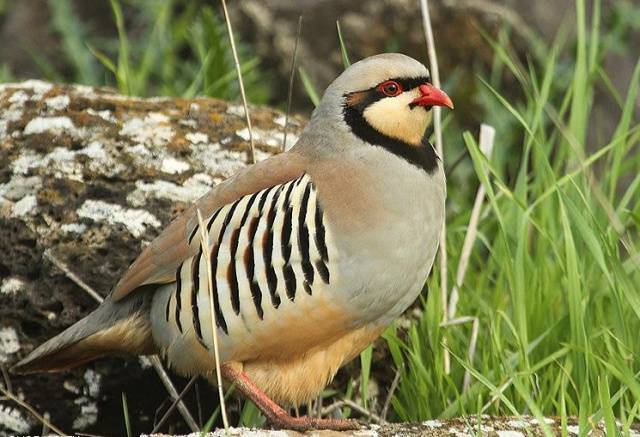
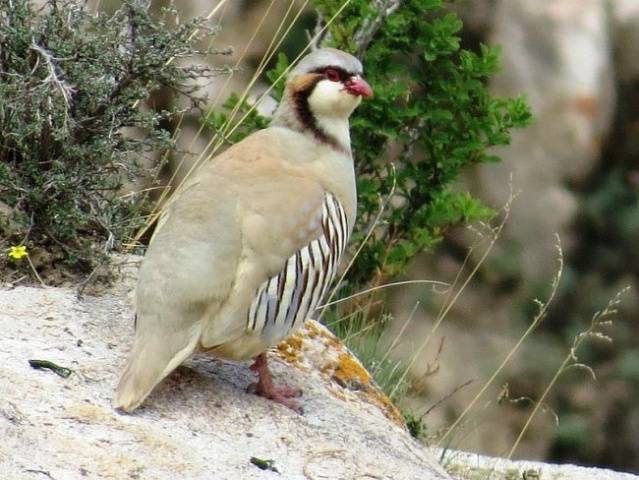
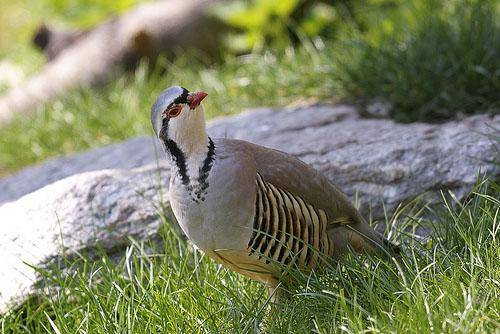

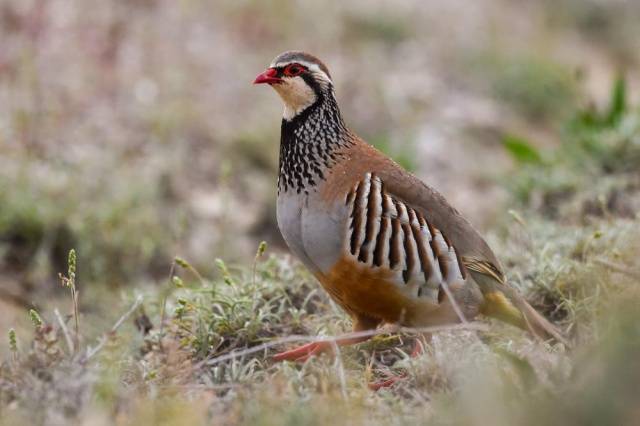
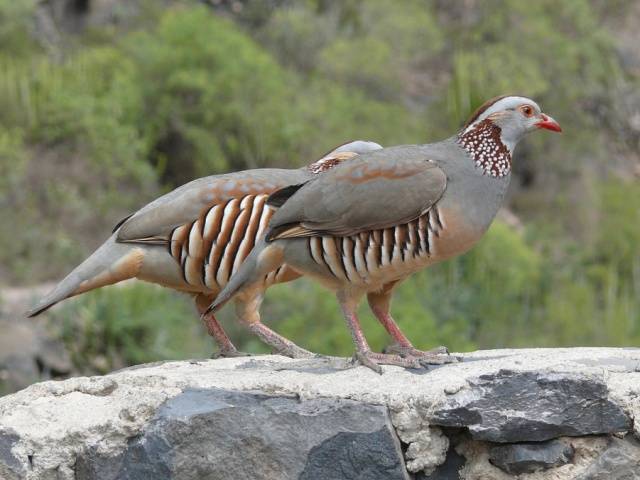
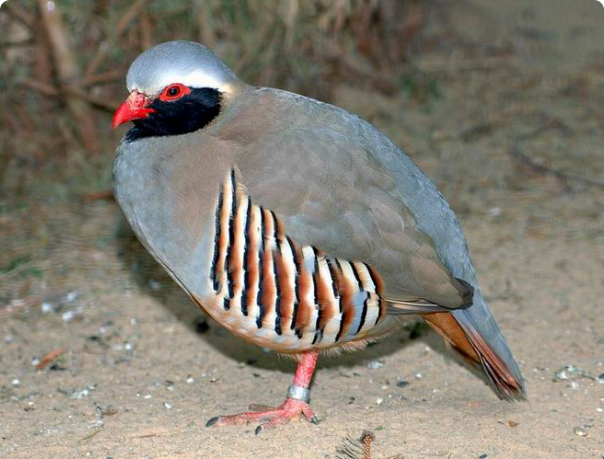
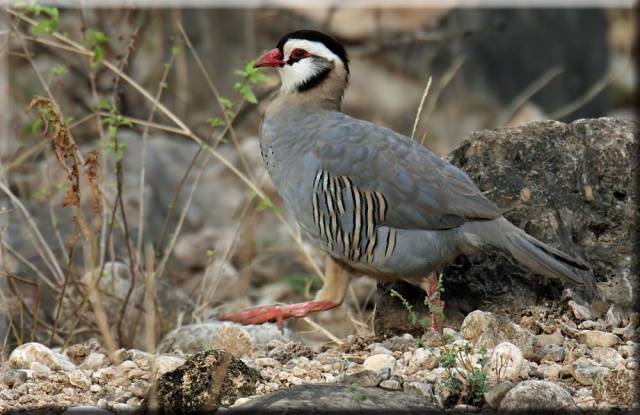
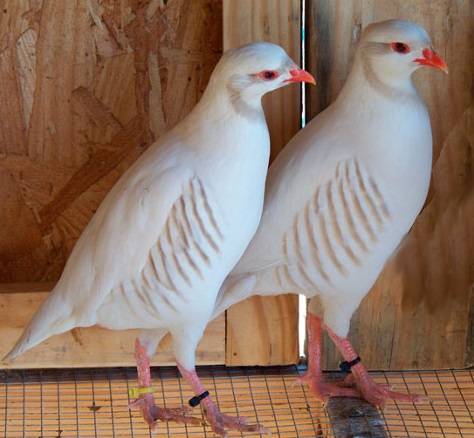

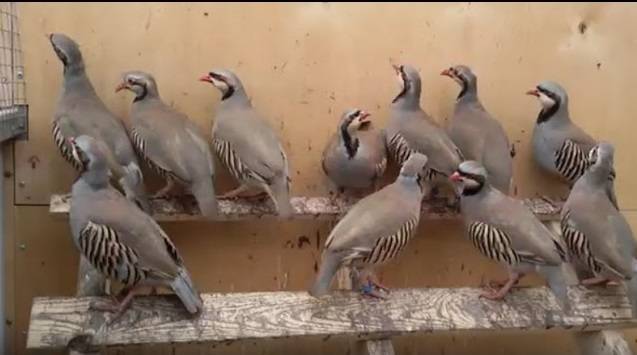
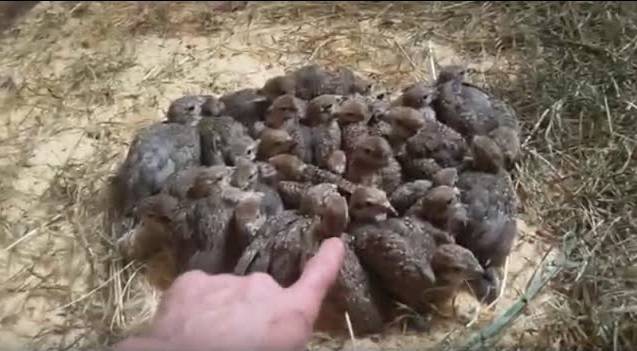



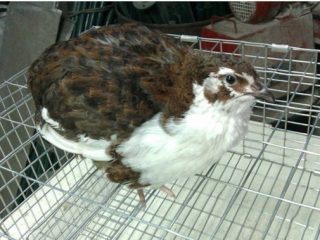
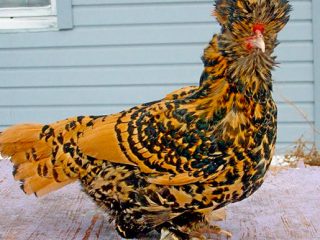
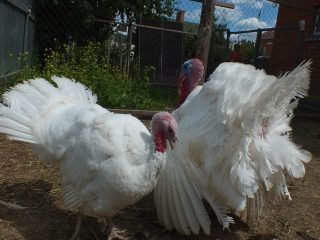

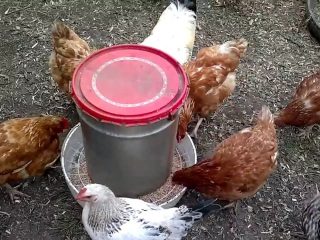

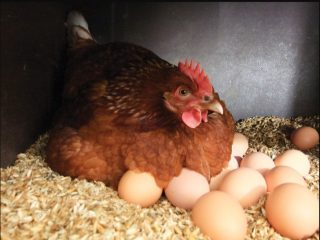

Good advice thanks. If you can distinguish the male as much as possible thanks
I want to buy keklik eggs from you
can you buy kekliks?
Good afternoon, Alena, I still have a question for you, can a female chukarok have a spur?
Feeding is the same as for chickens, but with an increased need for protein. Kekliks can be fed with compound feed for broilers.
tell me what to feed?
Once again, thank you so much!
There is no such thing that a living creature does not hurt. If there is a living organism, then its natural enemies must also exist in the microcosm. When they just started to massively breed quails, sellers argued that quails do not get sick with common bird diseases. This helped to sell birds at a higher price. Over time, it turned out that quails were sick no less than chickens.
The situation is similar with chickpeas. Partridges suffer from the same diseases as other pheasant. It is unlikely that the owners of kekliks are deliberately deceiving. It's just that with a small number of birds, there is less risk of infection of birds. In industrial cultivation, the same measures are applied to chickens as for chickens. That is, they carry out the prevention of diseases with pullorosis, heterocytic disease, Newcastle disease and coccidiosis. All measures: both deworming and the prevention of infectious diseases, are carried out in the same way as with chickens or quails, but taking into account the weight of the chickens.
In addition to infectious diseases, kekliks can have calcium metabolism disorders: rickets. They are treated by soldering fat-soluble vitamins, calcium preparations and walking in the sun.
When a bird of different ages or different families is kept in an aviary in a group, chukliks can experience stress. Then fights begin, ripping out of each other's feathers and self-talk. Strictly speaking, you cannot call it a disease, but productivity decreases.
Sorry, I still have a question about veterinary care. They say the chukots do not get sick, and when kept in captivity they are given some kind of vaccination, deworming, etc.?
Alena thank you very much for the enlightenment.
Hello! Kekliks are affected by closely related breeding in the same way as any other animal. That is bad. Normally, inbreeding is permissible to consolidate any desired trait. But this technique cannot be abused. Small populations "stewed in their own juice" for a long time usually degenerate. In chukeks, this can be expressed in the grinding of individuals (a vivid example: island dwarf animal species) or in the appearance of a large percentage of congenital deformities.
If possible, a small population should be infused with fresh blood to minimize the unwanted accumulation of genetic changes. It is usually difficult to get "alien" chippers, as few people breed this bird.If it is not possible to get an "outside" chukar, it is necessary to conduct a strict selection among your breeding herd, rigidly rejecting individuals with signs of degeneration. But this is possible only with a sufficiently large population of at least 300 individuals. With a smaller amount, degeneration is inevitable, although it will come later.
The largest of the chukots is black-headed. Lives in the Arabian Peninsula. The weight of females is a little more than 500 g, males are 700 g. The weight of the Asian parthuman, the most common in captivity, ranges from 350 to 800 g. You can try to select the largest population by selection.
Tell me also which of the varieties of kekliks is the largest?
Thank you for the previous answer, I still have a question of such a plan, how does closely related breeding affect chippers? Do I need to infuse someone else's blood?
Hello!
It is best to answer this question with the common phrase "you can't, but if you really want to, you can."
In fact, keeping multiple female partakers with one male depends on what the bird owner wants to get.
All partridges are monogamous birds that form pairs. But practice shows that under artificial conditions, when kept in cages, it is possible to add one male to several females.
In partridges, intraspecific aggression is quite well developed, therefore, when several females are kept in the same cage during the mating season, they will conflict with each other. The male does not care, he will fertilize everyone if the number of females does not exceed 4. But due to stress and aggression from relatives, egg production in females will be reduced.
Kekliks are no exception in this regard. They can also be kept in cages during the mating season at the rate of 2 - 4 females per 1 male. So that the birds in the heat of fights do not pierce the eggs with their claws, the floor of the cage should be inclined so that the egg can roll out.
It is also very important what kind of bird you are going to mate. If these are chukots taken from nature, then their intraspecific aggression can be very high. If this is a line that has been bred for a long time in captivity, then such chippers have largely lost their fear of a person, do not “faint” when a person appears in an aviary, do not seek to kill themselves against a fence if you try to catch them. Guinea fowls are much more wild than domesticated chickpeas.
The tendency to interspecific and intraspecific aggression in domesticated chickpeas is also reduced. Moreover, interspecies aggression is reduced so much that even adolescent chickens can intimidate them. But this only applies to lines that have been bred in captivity for several decades.
In your case, you will have to decide which is easier and cheaper: to lose a certain number of eggs due to reduced egg production or to feed an additional number of male chippers.
Tell me, during the mating season in one cage you can keep one male chukar, and several females?